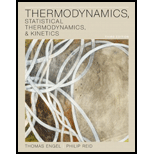
(a)
Interpretation:
At the transition temperature of 95.40C, the enthalpy of transition from rhombic to monoclinic sulfur is 0.38 kJ mol-1. The entropy of transition under these conditions, needs to be calculated.
Concept Introduction :
The entropy of transition is defined as below:
Here,
(b)
Interpretation:
At its melting point, 1190C, the enthalpy of fusion of monoclinic sulfur is 1.23 KJ mol-1. The enthalpy of fusion needs to be calculated.
Concept Introduction :
The entropy of transition is defined as below:
Here,
(c)
Interpretation:
The values of the enthalpy and entropy of fusion in parts (a) and (b) to those appropriate for S8 needs to be converted.
Concept Introduction :
The entropy of transition is defined as below:
Here,
Want to see the full answer?
Check out a sample textbook solution
Chapter 5 Solutions
Thermodynamics, Statistical Thermodynamics, & Kinetics
- What is the sign of the standard Gibbs free-energy change at low temperatures and at high temperatures for the explosive decomposition of TNT? Use your knowledge of TNT and the chemical equation, particularly the phases, to answer this question. (Thermodynamic data for TNT are not in Appendix G.) 2C7H5N3O6(s) 3N2(g) + 5H2O() + 7C(s) + 7CO(g)arrow_forwardConsider planet Earth as a thermodynamic system. Is Earth thermodynamically or kinetically stable? Discuss your choice, providing as many arguments as you can tosupport it.arrow_forwardTitanium has a normal melting point of 1668 °C and a molar enthalpy of fusion of 14.15 kJ mol-1 . The standard molar entropy of liquid titanium is 97.53 J mol-1 K-1 at 1668 °C. What is the standard molar entropy of solid titanium at this temperature?arrow_forward
- Whenever a gas expands isothermally, such as when you exhale or when a flask is opened, the gas undergoes an increase in entropy. A sample of methane gas of mass 15 g at 260 K and 105 kPa expands isothermally and (a) reversibly, (b) irreversibly until its pressure is 1.50 kPa. Calculate the change in entropy of the gas.arrow_forwardCalculate the enthalpy of vaporization of SO2 at –25°C if the same at its boiling point (i.e. –10°C) be 5950 cal mol–1. Given for SO2, molar heat capacities in liquid and vapor phase are 206 cal K–1 mol–1 and 9.3 cal K–1 mol–1 respectively.arrow_forwardCalculate the change in entropy when one mole of metallic aluminum is heated at one bar pressure from an initial temperature of 25 ℃ to a final temperature of 750 ℃. The molar heat capacities of solid and liquid aluminum at one bar pressure are 29.2 J mol-1 K-1 and 31.75 J mol-1 K-1, respectively. The specific enthalpy of fusion of aluminum at its melting point (660.46 ℃) is 396.57 J g-1. The molar mass of aluminum is 26.98 g mol-1. (Please explain as much as possible. Why did you use the equation? Or what conditions did you see from the question? etc)arrow_forward
- The molar volume of a certain solid is 161.0 cm3 mol−1 at 1.00 atm and 350.75 K, its melting temperature. The molar volume of the liquid at this temperature and pressure is 163.3 cm3 mol−1. At 100 atm the melting temperature changes to 351.26 K. Calculate the enthalpy and entropy of fusion of the solid. E4B.5(b) The molar volume of a certain solid is 142.0 cm3 mol−1 at 1.00 atm and 427.15 K, its melting temperature. The molar volume of the liquid at this temperature and pressure is 152.6 cm3 mol−1. At 1.2 MPa the melting temperature changes to 429.26 K. Calculate the enthalpy and entropy of fusion of the solid.arrow_forwardIn the reaction 2A (g) + B(g)==>2C(g) + D(g), 3.00 mol A was mixed with 2 mol of B and 0.5 mol of D. The system was allowed to come to equilibrium. At equilibrium, 1.2 mol of C was present at a total pressure of 1 bar. Calculate the mole fractions of each species at equilibrium, K, and ΔGr at 298 K.arrow_forwardA closed, but not isolated system is in thermal contact with its surroundings. The system's volume is fixed at 7.3 L. Both the system and surrounds have a temperature of 25 °C. A chemical reaction occurs inside the system for which ΔrU = 11.38 KJ. (A) What is the change in entropy for the surroundings for the process, ΔSsurr? (B) What are the ranges of possible values for the change in entropy of the system, ΔSsys , for this process?arrow_forward
- The variation of the Gibbs free energyof a given substance with temperature is given byG = aT + b + c/T. Determine how the entropy andenthalpy of this substance vary with temperature.arrow_forwardCalculate the molar entropy of a constant-volume sample of argon at 270 K given that it is 154.84 J K–1 mol–1 at 298 K. Unit in J/mol-K.arrow_forwardThe molar enthalpy of fusion of ice at 273.15 K and one atm is ΔfusHm (H2O)=6.01 kJ mol-1, andthe molar entropy of fusion under the same conditions is ΔfusSm (H2O)=22.0 J K-1 mol-1. Show that(a) ΔfusGm (H2O)=0 at 273.15 K and one atm, (b) ΔfusG,m (H2O) < 0 when the temperature is greaterthan 273.15 K, and (c) ΔfusGm (H2O) > 0 when the temperature is less than 273.15 K.arrow_forward
 Chemistry: The Molecular ScienceChemistryISBN:9781285199047Author:John W. Moore, Conrad L. StanitskiPublisher:Cengage Learning
Chemistry: The Molecular ScienceChemistryISBN:9781285199047Author:John W. Moore, Conrad L. StanitskiPublisher:Cengage Learning Chemistry: Principles and ReactionsChemistryISBN:9781305079373Author:William L. Masterton, Cecile N. HurleyPublisher:Cengage Learning
Chemistry: Principles and ReactionsChemistryISBN:9781305079373Author:William L. Masterton, Cecile N. HurleyPublisher:Cengage Learning Principles of Modern ChemistryChemistryISBN:9781305079113Author:David W. Oxtoby, H. Pat Gillis, Laurie J. ButlerPublisher:Cengage Learning
Principles of Modern ChemistryChemistryISBN:9781305079113Author:David W. Oxtoby, H. Pat Gillis, Laurie J. ButlerPublisher:Cengage Learning Chemistry: Principles and PracticeChemistryISBN:9780534420123Author:Daniel L. Reger, Scott R. Goode, David W. Ball, Edward MercerPublisher:Cengage Learning
Chemistry: Principles and PracticeChemistryISBN:9780534420123Author:Daniel L. Reger, Scott R. Goode, David W. Ball, Edward MercerPublisher:Cengage Learning



